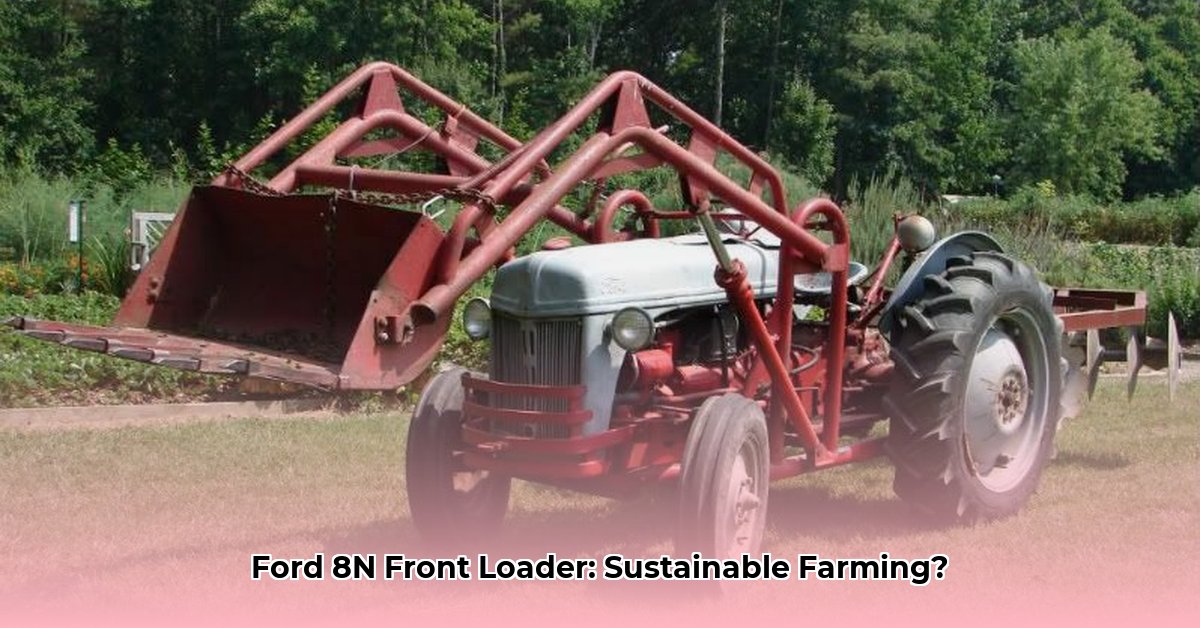
The Ford 8N tractor holds a nostalgic place in agricultural history, appreciated for its durability and simplicity. However, the desire to retrofit a front-end loader onto this classic machine often leads to unforeseen challenges. This article explores the feasibility of such a modification, considering mechanical limitations, economic implications, and the principles of sustainable agriculture. For more info on 8N loaders, see this guide. We will conclude that, in most cases, modifying an 8N for a loader is not a practical or sustainable solution.
The 8N's Limitations: A Realistic Assessment
While the Ford 8N excels in certain tasks, its design limitations preclude efficient and safe front-end loader operation. Its front axle, originally engineered for lighter implements, lacks the structural integrity to reliably support the stresses of heavy lifting. This weakness is exacerbated by the absence of power steering, making precise maneuvering with a loaded bucket exceedingly difficult and potentially dangerous. The original hydraulic system (if equipped) is insufficient, requiring a complete overhaul. This adds significantly to the overall cost and complexity of the project. In short, the 8N is fundamentally mismatched to the demands of consistent heavy lifting.
Mechanical and Operational Challenges: A Detailed Examination
Modifying an 8N for a front-end loader necessitates extensive changes, going beyond a simple bolt-on installation. It involves reinforcing – or, more likely, replacing – the front axle, installing a new and significantly more powerful hydraulic system, and potentially adding power steering. This requires substantial welding expertise, specialized parts, and significant mechanical knowledge. Even with these modifications, the tractor's original engine and transmission might not be robust enough for the sustained stress of loader operation, leading to increased wear and tear and higher risk of mechanical failures. This can greatly reduce the operational efficiency and longevity of the modified tractor. This undertaking is far beyond a simple upgrade.
Case Studies: Lessons Learned
While anecdotal evidence exists of successful 8N loader modifications, these examples typically involve significant compromises. These usually result in severely limited lifting capacity and significantly reduced operational safety. The cost of achieving even a minimally functional setup often exceeds the tractor’s current or resale value, making the investment economically unsound. These cases highlight the considerable difficulties and potential risks involved in such modifications.
Economic Feasibility: A Cost-Benefit Analysis
A comprehensive cost analysis reveals the financial impracticality of this modification. The expense of loader components, the specialized labor required for the various modifications, and the increased maintenance and repair costs far outweigh the potential benefits. Comparing this total cost to the purchase price of a used tractor already equipped with a loader reveals a clear economic advantage in acquiring a machine better suited to the task. The financial burden of attempting to modify an 8N should not be underestimated.
Sustainable Agriculture Considerations: Long-Term Implications
Modifying an 8N for a front-end loader directly contradicts the principles of sustainable agriculture. Increased maintenance, reduced operational efficiency, heightened risk of accidents, and an increased strain on the operator collectively diminish overall farming productivity. Furthermore, the increased fuel consumption associated with an overworked engine contradicts environmentally responsible practices. Sustainable farming demands efficient, safe, and reliable machinery; attempting to adapt an 8N into a loader presents a substantial obstacle to these goals.
Recommended Alternatives: Practical and Sustainable Options
Rather than attempting a problematic modification, several practical and sustainable alternatives exist. Renting a loader for occasional use provides cost-effective access to the necessary equipment without the expense and risks of modification. Investing in a used tractor designed for loader work, while a larger upfront investment, offers increased efficiency, enhanced safety, and reduced maintenance costs over time. Exploring cooperative farming arrangements enables sharing of resources and equipment, thereby avoiding the need for individual ownership. In essence, there is a multitude of more efficient options than trying to retrofit an 8N.
Conclusion: Prioritizing Practicality and Safety
While some may successfully modify an 8N for a loader, the inherent mechanical limitations, significant costs, and substantial risks associated with such an undertaking generally outweigh any perceived benefits. A holistic assessment considering economic feasibility and the principles of sustainable agriculture strongly suggests that exploring alternative solutions is the far superior approach—ensuring both efficiency and safety in agricultural operations. The Ford 8N, a valuable asset in its intended applications, is not ideally suited for the rigorous demands of front-end loader work.